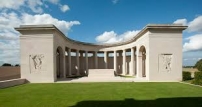| First Name: | Frederick Arthur | Last Name: | WELLS | |
|---|---|---|---|---|
| Date of Death: | 30/11/1917 | Lived/Born In: | Nunhead | |
| Rank: | Rifleman | Unit: | London6 | |
| Memorial Site: | Cambrai Memorial, Louverval, France | |||
Current Information:Age-23 117, Ivydale Road, Nunhead
The Battle of Cambrai This was a major British offensive on the Western Front that was launched on 20th November, 1917 and lasted through to the beginning of December. As the name suggests it was an attack towards the city of Cambrai and the important German railhead there, which it was hoped would be captured. The battle was notable for two things: the massed use of tanks for the first time and the success of the first day’s fighting when the formidable Hindenburg Line was breached and gains of five miles were made in places. In celebration the church bells throughout Britain were rung. However this success was short lived. The tanks were not reliable and the German defence stiffened as the fighting progressed and when they counter attacked in force on 30th November, the British came under so much pressure that they were forced to withdraw from many of the positions they had captured earlier on. Both sides suffered around 45,000 casualties during the course of the fighting. The initial success at Cambrai was short-lived. German resistance stiffened as fresh troops were rushed to the battlefield to help stem the allied advance, the threat from the tanks diminished as many of them broke down and on 30th November came a major offensive by the enemy. 47th Division had moved into the front line in and around Bourlon Wood in the northern part of the battlefield during the night of 28th-29th November with 141 Brigade on the right and 140 Brigade on the left. When the attack was launched on 30th November, 6th London of 140 Brigade were holding the ridge to the west of Bourlon Wood with 15th London on their right and 19th London in a support position in the woods. The German artillery bombardment, which included many gas shells, began at 9.30am and was followed by an infantry attack on the left of 6th London as a result of which the enemy were able to work their way through between them and 2nd Division to their left. By 2pm, this flanking movement together with a powerful frontal assault drove the survivors of of 6th London off the crest of the ridge. This in turn threatened the left flank of 15th London who had to form a defensive flank along the edge of the wood. The reserve company of 6th London and a company of 8th London counter attacked and regained some ground but did not re-take the ridge. 6th London suffered nearly 400 casualties during the course of the day, one of whom was Frederick Wells. |
||||
| « Back to Search Results | ||||
| If you think any of the information shown here is incorrect, Click Here to submit your amends and comments | ||||




